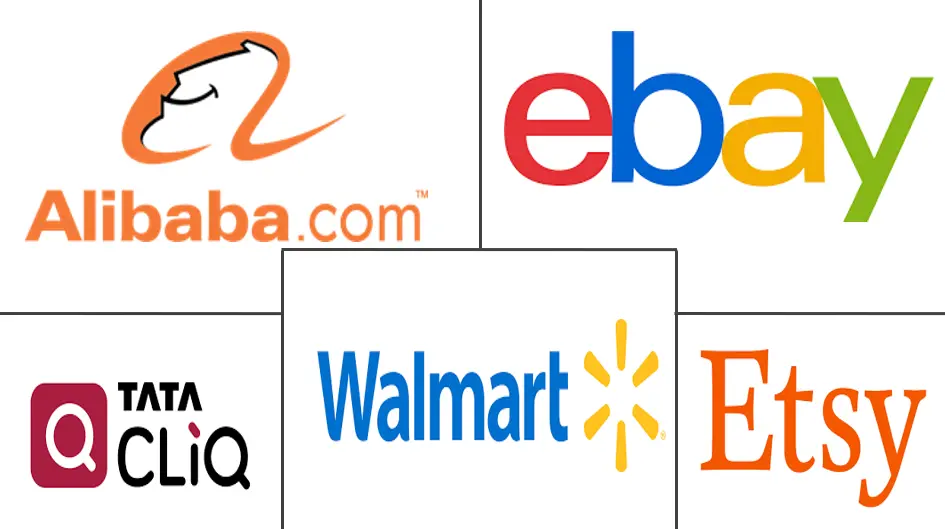E-commerce App Market Size and Share
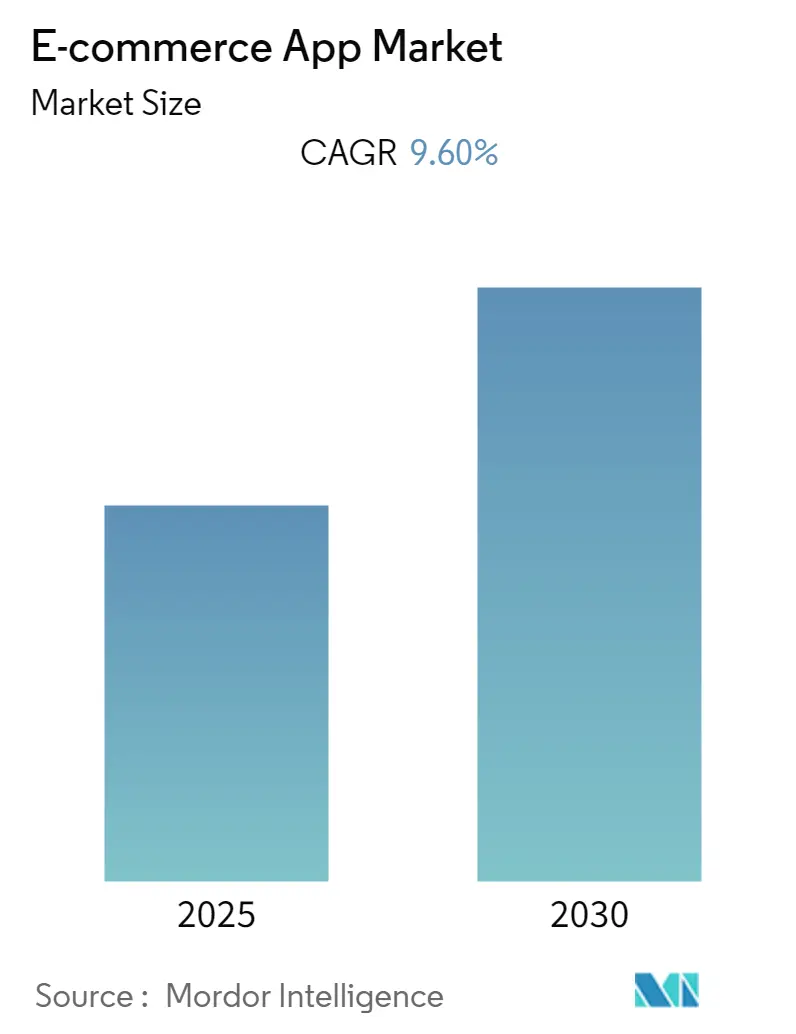
E-commerce App Market Analysis by Mordor Intelligence
The E-commerce App Market is expected to register a CAGR of 9.6% during the forecast period.
- A boost to the market's expansion is also being given by rising internet usage and the use of gadgets like smartphones and tablets to access e-commerce apps. The rapid growth of the e-commerce sector is attributed to the prevalence of mobile devices and their continuous hegemony over desktop computers.
- The demand for desktop applications has quickly surpassed that for mobile apps, which now rule the digital economy. More than 5 million apps were available between the Google Play Store and the Apple App Store as of 2021. Adopting mobile apps has become essential to digital lifestyles all around the world, particularly when it comes to social networking.
- The main challenge of e-commerce apps is maintaining a consistent sense of security for customers. These apps must provide secure online transactions while safeguarding users' private information. Any successful attempt to access a customer's data can severely damage an e-commerce company's brand and clientele. It is crucial to concentrate on app security, given the rising incidence of cybercrimes and the rising risk of malware activities.
- Using mobile devices, consumers can connect with brands around-the-clock. These portable electronics have enhanced how customers connect with brands, find information, and shop. Online shopping apps on mobile devices are becoming more and more popular. Therefore, businesses must incorporate such tools into their marketing strategies. This will help to improve the way the brand interacts with customers.
- During the pandemic, everything from groceries to luxuries had to be purchased online, during which time the download and use of e-commerce apps escalated. The major players-Amazon, Walmart, Alibaba, and others-have been growing quickly during the past three years.
Global E-commerce App Market Trends and Insights
Use of Emerging Technologies Aids Market Growth
- Mobile apps will continue to exist for a very long time. For e-commerce apps to be competitive, they need to be digitally agile. Shopping and e-commerce apps created for these relatively new technologies are gaining ground in the mobile app market. Many businesses have embraced several emerging technologies to offer seamless experiences to their customers across all channels to keep up with the always-changing consumer behavior.
- Sales from smartphones would lead in the current year, which is not surprising given the growth of mobile shopping. Using apps, consumers aren't only surfing but also making purchases. A mobile app offers orders with an average order value of USD 102, compared to an average order value of a mobile website of USD 92. Also, numerous gadgets can access mobile websites and apps. In general, mobile devices can be divided into two groups, smartphones and tablets.
- The use of Artificial Intelligence (AI) has pushed voice assistants such as Siri and Alexa into the e-commerce app market. The consumer now uses voice search for product reviews, add them to their shopping list, track the package, provide ratings, contact the chatbot assistant, and so on. The e-commerce market has now been successfully penetrated by voice search. By this year, voice shopping is predicted to generate approximately USD 40 billion. That's a rise of 1,900% in just four years from a modest USD 2 billion in 2018.
- Meanwhile, Augmented Reality (AR) is already being used by mobile shopping apps to enhance user experience. There are countless potential applications for this kind of technology. For instance, a company that sells furniture online can utilize augmented reality to show potential customers how a product will look in their house. This technology allows people to select a color and see whether an item will truly fit in the required place. The AR and VR market is predicted to grow to USD 35 billion by 2025.
- Android users have 3.55 million apps to pick from during the third quarter of the last year, making Google Play the app store with the largest selection. With almost 1.6 million iOS apps available, the Apple App Store was the second-largest app store. Even though Apple and Google frequently remove poor-quality content from their app stores, the precise number of apps is increasing over time.
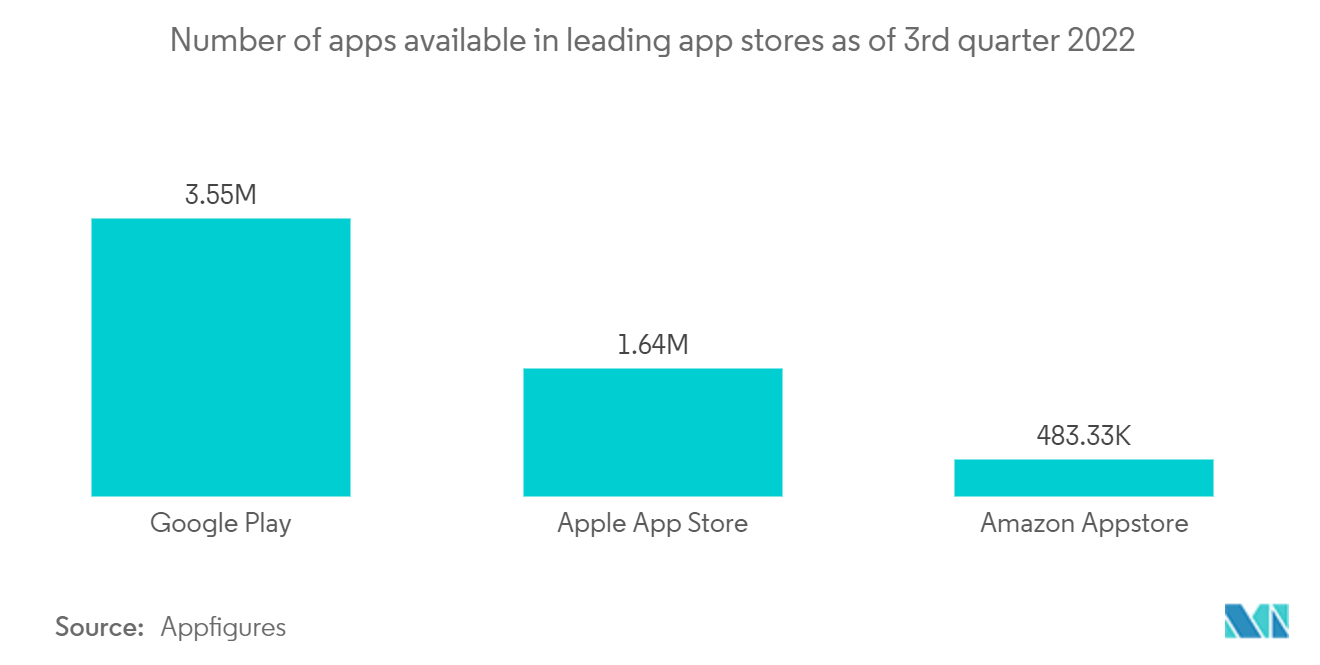
Significant Market Growth is Expected in Asia Pacific.
- The Asia-Pacific (APAC) area is experiencing rapid growth in e-commerce firms. This pattern will persist through 2023 and beyond. A major portion of all e-commerce sales worldwide comes from Japan, China, and South Korea, three of the region's top e-commerce marketplaces. Moreover, during the projection period, growth is anticipated to persist. Taobao, Pinduoduo, JD, Taote, and VIPshop are the top e-commerce applications on the basis of monthly active users.
- With its Taobao and Tmall apps, Alibaba has stepped into the shoes of both Amazon and eBay in China, where Amazon is banned. JD.com, which had approximately 569 million active accounts in 2021, is another tough rival. China is also at the forefront of emerging forms of e-commerce, such as social commerce, invented by Pinduoduo and directly links producers and farmers with consumers.
- Asia Pacific has experienced a rapid increase in internet accessibility and penetration, which has sparked the region's following digitization. The rising use of mobile devices in Asia is likely the biggest driver of internet consumption, with device prices falling and internet plan subscription costs falling. With the escalating mobile phone usage, E-commerce applications are now getting more frequently downloaded and used.
- The top three regional e-commerce applications used monthly in the Asia-Pacific region are Lazada, Shopee, and Meesho. Also, the three apps had outpaced Amazon globally in total downloads. With 211 million downloads in 2021, Shopee has the most users, and a significant portion came from Southeast Asia. Indian e-commerce app Meesho, with 162 million downloads, came in third. Meesho received almost all his downloads from India.
- Notably, the Asia-Pacific region's e-commerce apps market has expanded dramatically on the back of a huge technology-driven young population in the countries of China, Indonesia, Singapore, and Japan. Local e-commerce platforms in some APAC markets, such as Flipkart for India, Coupang for South Korea, and Taobao for Hong Kong, are ranked first. Amazon, a major online retailer, took the top spot in the APAC regions of Australia and Japan.
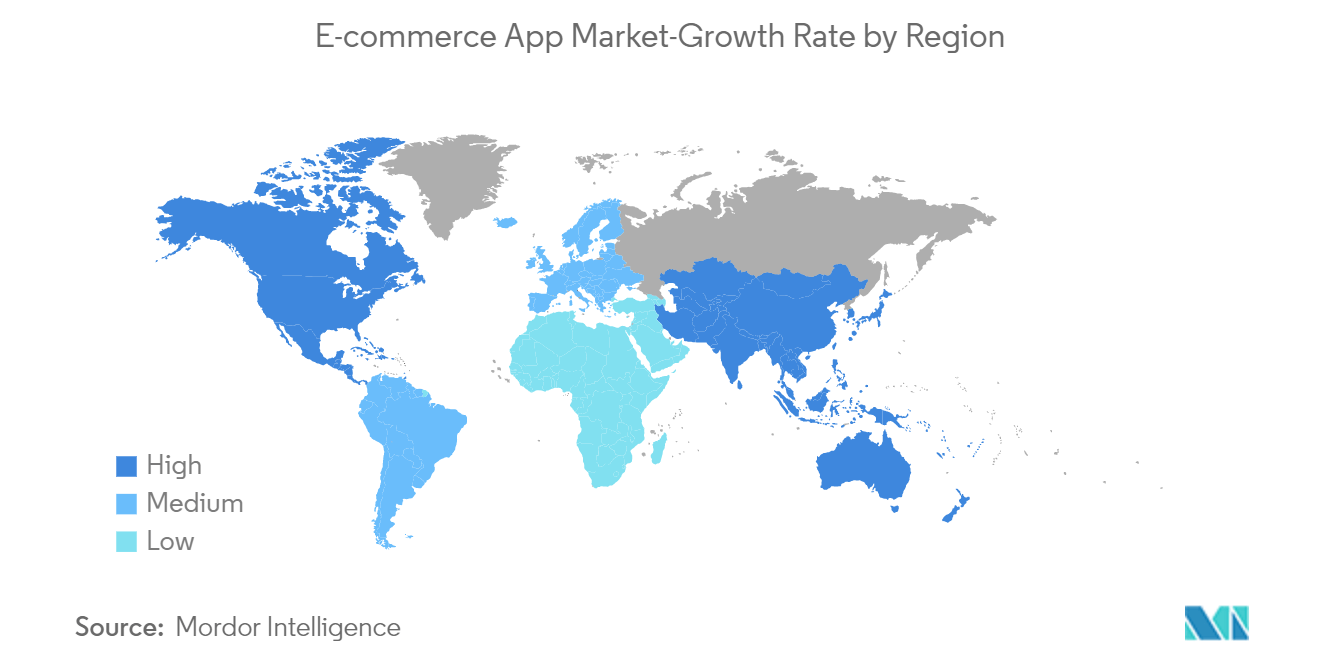
Competitive Landscape
The E-commerce App Market is fragmented as it consists of several market players. Many key players in the market are in constant efforts to bring advancements. A few prominent companies are entering into collaborations and expanding their global footprint in developing regions to consolidate their positions in the market. The major player in this market includes eBay, Tata Cliq, Walmart, Etsy, Inc., Alibaba.com, and many others.
- In November 2022, Tata CliQ officially announced the launch of an online fashion offering, Le Mill, a multi-brand fashion firm founded by Frenchwomen Julie Leymarie and Cecilia Morelli Parikh. Through this partnership, Indian shoppers would access worldwide brands of clothing, accessories, and footwear owing to Le Mill's cooperation with Tata CLiQ Luxury.
- In June 2022, Etsy launched a purchase protection program for purchasers and sellers. As per the program, the customer will receive a full refund if an item purchased on Etsy.com doesn't match the item description, doesn't come, or doesn't arrive at all. To make the issue resolution process as simple and effective as possible for both consumers and sellers, Etsy will continue to invest in product and customer service improvements in addition to the purchase protection program.
E-commerce App Industry Leaders
-
eBay
-
Tata Cliq
-
Alibaba.com
-
Walmart
-
Etsy, Inc.
- *Disclaimer: Major Players sorted in no particular order
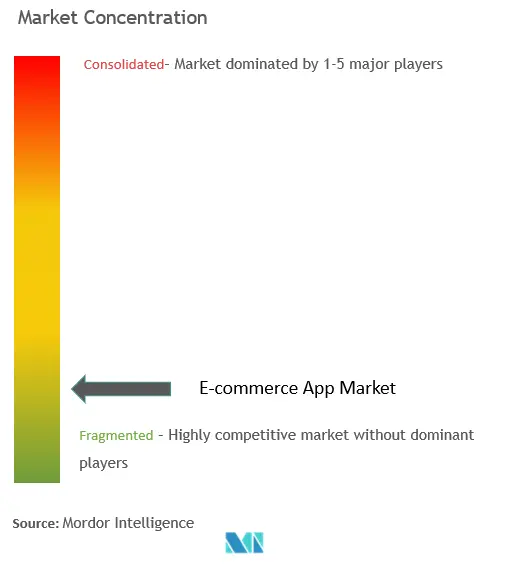
Recent Industry Developments
- In October 2022, Flipkart, a Walmart subsidiary and a major Indian online retailer, introduced a metaverse purchasing experience. The latest venture from the Indian e-commerce giant experiments with web3 solutions to enhance its customer experience and offer them a more interactive way to find and shop new products. The business is launching the metaverse service, Flipverse, in collaboration with eDAO, a Polygon-incubated business.
- In June 2022, eBay disclosed the introduction of eBay Live, a specialized shopping platform that enables customers to make purchases in a real-time, interactive setting. The inaugural live shopping event hosted by the firm would include a handpicked collection of uncommon trading cards from eBay vendor Bleecker Trading.
Global E-commerce App Market Report Scope
The shopping category includes apps linked to well-known e-commerce companies and online merchants. These apps facilitate purchases while also promoting special deals and promotions. A few apps that facilitate C2C (consumer-to-consumer) transactions, such as eBay and Etsy, are also mentioned.
The E-commerce App Market is segmented by Type (In-app Purchases, Advertisement), Platform (Android and iPhone), and Geography (North America, Europe, Asia Pacific, Latin America, and the Middle East and Africa). The market sizes and forecasts are provided in terms of value (USD million) for all the above segments.
| In-app Purchases |
| Advertisement |
| Other Types |
| Android |
| iPhone |
| North America |
| Europe |
| Asia Pacific |
| Latin America |
| Middle East and Africa |
| By Type | In-app Purchases |
| Advertisement | |
| Other Types | |
| By Platform | Android |
| iPhone | |
| By Geography | North America |
| Europe | |
| Asia Pacific | |
| Latin America | |
| Middle East and Africa |
Key Questions Answered in the Report
What is the current E-commerce App Market size?
The E-commerce App Market is projected to register a CAGR of 9.6% during the forecast period (2025-2030)
Who are the key players in E-commerce App Market?
eBay, Tata Cliq, Alibaba.com, Walmart and Etsy, Inc. are the major companies operating in the E-commerce App Market.
Which region has the biggest share in E-commerce App Market?
In 2025, the Asia-Pacific accounts for the largest market share in E-commerce App Market.
What years does this E-commerce App Market cover?
The report covers the E-commerce App Market historical market size for years: 2019, 2020, 2021, 2022, 2023 and 2024. The report also forecasts the E-commerce App Market size for years: 2025, 2026, 2027, 2028, 2029 and 2030.
Page last updated on:
E-commerce App Market Report
Statistics for the 2025 E-commerce App market share, size and revenue growth rate, created by Mordor Intelligence™ Industry Reports. E-commerce App analysis includes a market forecast outlook for 2025 to 2030 and historical overview. Get a sample of this industry analysis as a free report PDF download.
